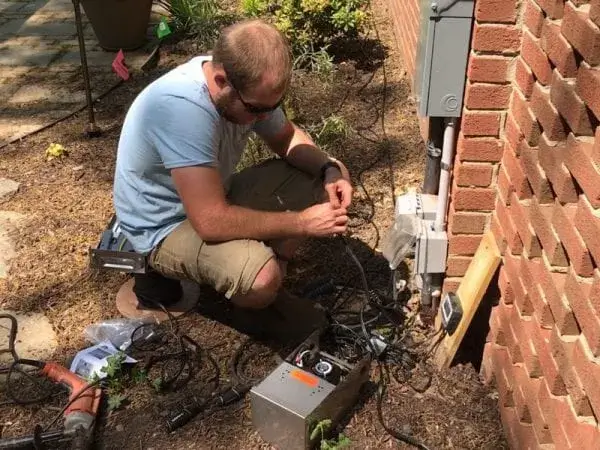
What Is A Transformer And What Does It Do?
Low Voltage Landscape Lighting Transformers: Electric Blue: Safety, Efficiency, and Easy Installation (303) 790-8813
Unlock the benefits of low voltage landscape lighting! Learn how transformers ensure safety, reduce costs, and simplify installation for a stunning outdoor ambiance. A transformer converts voltage received from one or more circuits by either increasing it or decreasing it in order to meet the energy requirements of the light fixture(s). This is done in order to either collect electricity to go to a larger receiver or to disperse electricity to multiple receivers. Transformers are found everywhere a voltage needs to be converted, including homes.
The Power of Transformation:
• Safety First: Your home’s electrical grid operates at around 120 volts (line voltage) – a potential safety hazard outdoors.
• Stepping Down for Safety: A transformer acts as a superhero, converting this high voltage to a much safer level, typically 12 volts, perfect for low voltage landscape lighting.
The Circuit: A Closed Loop for Efficiency:
• Complete Connection: Low voltage systems utilize a closed circuit. Electricity flows from the transformer:
o Through a wire to each lighting fixture.
o Back to the transformer via a separate return wire, completing the loop.
Simplified Wiring:
• Thin and Easy: Low voltage wires are much thinner and easier to handle compared to bulky line voltage wires.
• Shallow or Surface Installation: They can be buried minimally (around 3 inches) or laid on top of the ground, minimizing trenching needs.
• Reduced Shock Risk: The lower voltage minimizes the risk of electrical shock if a wire is accidentally damaged.
Light Up Your Landscape in Style:
• Dedicated Fixtures: Low voltage systems require special fixtures designed for the lower voltage.
• Energy Efficiency: These fixtures often boast superior energy efficiency compared to traditional outdoor lights.
• Design Freedom: A wide variety of styles exist, including path lights, spotlights, and well lights, to create stunning effects in your outdoor haven.
Why You Need a Transformer:
Standard household electricity isn’t ideal for outdoor lighting. Here’s why a transformer is essential:
• Safety: Transformers prevent the dangers of high voltage in outdoor environments.
• Efficiency: They ensure your landscape lighting system operates efficiently, reducing wasted energy.
• Compatibility: Transformers allow you to connect multiple low voltage fixtures on the same circuit, maximizing your design potential.
Incorporating a transformer into your low voltage landscape lighting system unlocks a world of benefits – safety, efficiency, and a simplified installation process. Let your creativity flow and illuminate your outdoor space with confidence!
Why You Need a Transformer for Low Voltage Landscape Lighting (SEO Optimized)

Don’t Be in the Dark! Why You Need a Transformer for Low Voltage Landscape Lighting
Unveiling the secret behind safe and stunning outdoor illumination! Explore why transformers are essential for low voltage landscape lighting and how to choose the right one.
Imagine transforming your outdoor space into a magical wonderland bathed in warm, inviting light. Low voltage landscape lighting makes this dream a reality, but a crucial component ensures safety and efficiency: the transformer. Let’s delve into why transformers are vital for low voltage lighting systems.
Standard Electricity vs. Low Voltage Safety:
• Household Danger: Homes typically utilize 120-volt electricity, posing a potential safety hazard outdoors.
• Stepping Down for Safety: A transformer acts as a superhero, converting this high voltage to a much safer level, usually 12 volts, perfect for low voltage landscape lighting.
All About Transformers:
• Do LEDs Need Transformers? Absolutely! While some lights have internal transformers, complex LED landscape lighting systems require an external transformer to power multiple fixtures (patio, walkway, driveway, etc.).
Choosing the Right Transformer:
• Wattage is Key: To determine the ideal transformer size, you’ll need to calculate the total wattage of your lighting system. Simply multiply the number of lights by the wattage per light (e.g., 10 lights x 7.5 watts/light = 75 watts).
• Future-Proofing: Add up the wattage of all planned lighting systems. Then, multiply the total wattage by 1.25 to account for potential future additions and power surges.
• Common Transformer Size: Most landscape lighting applications are well-served by 300-watt transformers, powering walkway lights, patios, and other landscape features.
Sizing Up Your Needs:
• Simple Math for Minimum Wattage: Multiply your total light wattage by 1.25 for the current project. Consider future expansion when choosing a transformer size.
• Don’t Oversize: Avoid transformers double your wattage needs. Opt for the next size up if you plan on adding more lights later.
Beyond Wattage:
• Magnetic vs. Electronic: Both options offer similar efficiency, but electronic transformers are more compact, ideal for limited spaces.
• Weatherproof Enclosure: Always choose a transformer with a weatherproof enclosure for outdoor protection.
• Safe Placement: Locate your transformer near your lighting system to minimize voltage drop and close to a GFCI outlet for safety. Ideally, an electrician can install one if needed.
• Finding the Sweet Spot: Position the transformer at least 12 inches off the ground to avoid water damage. Consider wall mounting or using plantings or a privacy screen for a discreet placement.
By understanding the role of transformers and following these tips, you can create a safe, efficient, and beautiful low voltage landscape lighting system that enhances your outdoor haven for years to come.
Choosing the Perfect Transformer for Your Low Voltage Landscape Lighting
Power Up Your Landscape! Selecting the Right Transformer for Low-Voltage LED Lights
Dreaming of an enchanting outdoor ambiance illuminated by soft, energy-efficient lighting? Look no further than low-voltage LED landscape lighting! But before you start picking fixtures, there’s a crucial component to consider: the transformer. This unsung hero ensures the safe and efficient operation of your entire system.
Sizing Up Your Transformer Needs:
• Wattage Calculation: To choose the ideal transformer size, you first need to determine the total wattage of your lighting system. Simply multiply the number of lights by the wattage per light (e.g., 10 x 5 watts/light = 50 watts).
• Future-Proofing: Plan for potential expansion! Add the wattage of all planned lighting zones. Then, multiply the total wattage by 1.25 to account for future additions and power surges.
• Common Transformer Wattage: For most residential landscapes, a 300-watt transformer is sufficient to power walkway lights, patios, and other features.
Choosing the Right Transformer:
• Beyond Wattage: While wattage is essential, there’s more to consider. Here are some additional factors:
o Magnetic vs. Electronic: Both offer similar efficiency, but electronic transformers are more compact, ideal for limited spaces.
o Weatherproof Enclosure: Always choose a transformer with a weatherproof enclosure for outdoor protection.
Safe Transformer Placement:
• Location, Location, Location: Position your transformer near your lighting system to minimize voltage drop.
• GFCI Outlet Necessity: For safety, ensure the transformer is close to a Ground Fault Circuit Interrupter (GFCI) outlet. Consult an electrician for installation if needed.
• Finding the Sweet Spot: Place the transformer at least 12 inches off the ground to avoid water damage. Consider wall mounting or discreet placement using plantings or privacy screens (while maintaining electrician access).
